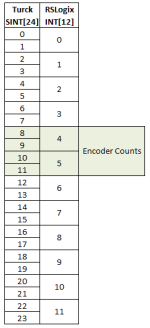jake4eng
Member
Hello All!
I am having difficulties mapping register values.
In the TURCK register there are 24 unique register bytes corresponding to different value registers (8bit x 24).
These 24(8bit) bytes were mapped into RSLOGIX 5000 as 12(16bit) INT words ....INT[12] ..
This means there are 2 bytes (2 unique register values) inside each INT word.
WHAT I NEED TO ACHIEVE:
1. (BLUE outline in drawing) Write/Map a value of "32" into byte 7 of the TURCK register so effectively starting at INT[5].8 in RSLOGIX
This will enable the value of CNT1 (encoder count) to be registered in bytes 8-11...
2. (PINK outline in drawing) READ/MAP the values registered in bytes8,9,10 and 11(4x8bits) into a SINGLE 32bit INT value which will tell me the CNT1 value of my encoder.
I am having problems when ever I try to COP a value of 32 (no matter what kind of array it's sourced from) into INT[5].8 & I haven't tried to map/read the values of bytes 8-11
PICTURE
http://forums.mrplc.com/applications/core/interface/file/attachment.php?id=16013
CAN SOMEONE PLEASE HELP EXPLAIN HOW TO ACHIEVE THIS?!
Thanks for your input EVERYONE!
I am having difficulties mapping register values.
In the TURCK register there are 24 unique register bytes corresponding to different value registers (8bit x 24).
These 24(8bit) bytes were mapped into RSLOGIX 5000 as 12(16bit) INT words ....INT[12] ..
This means there are 2 bytes (2 unique register values) inside each INT word.
WHAT I NEED TO ACHIEVE:
1. (BLUE outline in drawing) Write/Map a value of "32" into byte 7 of the TURCK register so effectively starting at INT[5].8 in RSLOGIX
This will enable the value of CNT1 (encoder count) to be registered in bytes 8-11...
2. (PINK outline in drawing) READ/MAP the values registered in bytes8,9,10 and 11(4x8bits) into a SINGLE 32bit INT value which will tell me the CNT1 value of my encoder.
I am having problems when ever I try to COP a value of 32 (no matter what kind of array it's sourced from) into INT[5].8 & I haven't tried to map/read the values of bytes 8-11
PICTURE
http://forums.mrplc.com/applications/core/interface/file/attachment.php?id=16013
CAN SOMEONE PLEASE HELP EXPLAIN HOW TO ACHIEVE THIS?!
Thanks for your input EVERYONE!





